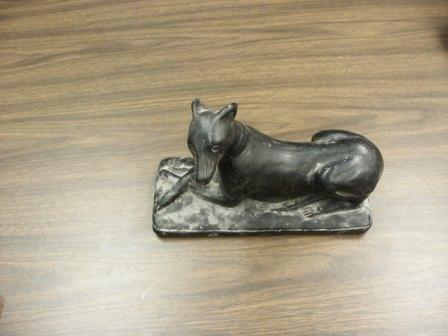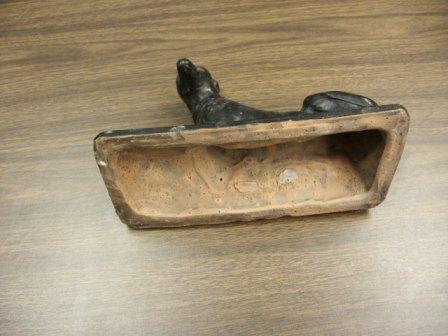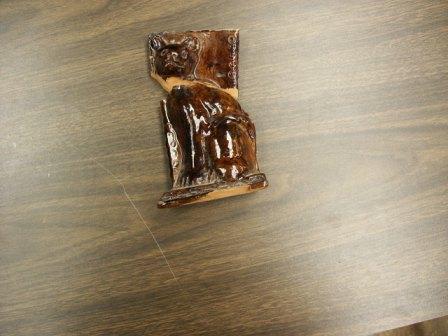|
Fakes and Reproductions
Because the
values of so many Shenandoah
pottery items have risen to lofty heights, much fakery and reproduction
has become wide spread throughout the collecting community. Some people
suffer integrity impairment and are hell bent to take advantage of the
innocent and unenlightened; especially the newcomer. Many sad and
unfortunate stories concerning fakeries have reached most of us. If it
looks like a duck, is colored like a duck and has duck marked on it, it
is not necessarily a duck; at least in the pottery world. There are two
definitive factors, among others, that ruin the faker's
objectives. One, and practically impossible to overcome, is
getting the maker's mark correct, when one is used. Without the
original potter's stamp 99.8 percent of the factitious maker's marks
reveal just what is there; a fake. Without the same clay, as that
used by the potter, in 99 percent of the cases, shrinkage of the mark
dimensions will differ even if the original stamp could have been
used. A portion of a millimeter can count when considering the
consistency of various clay shrinkages. Many marks were carved from
wood sources and many were constructed from atypical printer's type.
Some were cast in lead or brass. Some were mass produced and sold
in the general stores. All of the aforementioned processes would be
quite difficult to duplicate. Some original consistencies and
idiosyncrasies can be absent or detectable through magnification.
Even so, fakers are in too much of a hurry and suffer effort
impairment; therefore unbelievable marks are foolishly, hopefully, and
optimistically used.
The other
primary reason fakers are not successful in producing
"antique look-likes" is that the patina or coloration of the new item
will not match those from one hundred years ago, no matter what shades
of coloration are used. Those of you who have never placed a pottery
item into the kiln and then taken it out only to find that the next day
its hue has changed, may think that once ceramic items reach their
final temperature and then cool, their colors never change. This
is certainly not so. Pottery like a fine walnut tall clock case
will assume a noticeable patina according to its production
period. This effect occurs to both the glazed and unglazed clay.
Use-stains and wear will also cause an effect on patina. The use of
artificially applied wear, chips, and staining, to mimic and confuse as
an antiquity, is in practically all cases futile.
The surface appearance as it relates to patina or coloration of some
well protected and/or protracted storage, away from light and air flow,
of period pottery items can be very confusing. Many such items
are
called mint or as made condition. The trained eye can see the
effects
of age produced patina on such items.
Many fakers feel that they can enhance the certainty of their offers by
distressing the product. This can be by adding paint, by
producing fractures or breaking away portions, by adding dirt or false
dust, or many other creative intrusions to the finished surface of the
fake. These methods may fool the novice and some advanced collectors
but are only laughable to those with a well experienced eye.
Fear not, there is good news. First allow a rhetorical
question. "Why do fakers never offer their factitious products to
the expert? The
answer: Experts know the difference in 99.9 percent of these
situations. Experts realize what you have read here so far. There
are many
other faults that an expert can point out. Do you know an expert?
If
not, surely one lives very close to you. Most are quite happy to help.
The reproduction is a different story all together. If it has
been produced by an artist who cares, it will show the maker's
identification. If someone makes what they portray as a
reproduction and the only producer's mark identifies another maker,
they have broken local, state, and federal laws once it has been
offered for sale or even given away. Reproductions, in order to stay
within the good graces of our laws and collector's acceptance, should
be properly marked with the maker's identity. Reproductions can
be delightful, useful, helpful, collectable and valuable.
This site will make a serious effort to keep the user apprised of any
believable factitious product that can be identified and
photographed. This site will also endeavor to show items of
foreign makers that fit into the pattern of Shenandoah pottery.
Perhaps you have been "taken" through one or more of your acquired
pottery items. Your best answer is to require the seller, be it an
auction or individual, to do the ethical thing and reclaim it; most
will. Perhaps it is too late or for some reason that approach
will not work. Threaten or open a law suit. You can on the other hand
donate the
item(s) to a museum. Most museums today have a 'fakes and
reproductions' collection. These collections are often used for the
education of students and collectors.
This answer will allow you to possibly retrieve some of your investment
costs through the federal income tax system. Perhaps you know for sure
that the object(s) is a fake. You should bring the problem to the
attention of the local police in the area of purchase. If these
approaches fail and you have the stomach for it, use the hammer
treatment. This latter technique has worked for others. Divide
the resultant sherds into two equal portions, placing each separate
part into two different trash disposals. You are only a curator whose
term is uncertain. Protect your present and future fellow
collectors.
Most of them have or will experience similar circumstances.
But after all is said and done, believe it or not, EXPERIENCE is a very
good teacher. It is also required if you wish to be a serious
collector, investor, or
both.

The
photograph above exhibits two recent factitious products. The
Ewe and Lamb group in its period form is very rare. All originals
that have been identified thus far have been five in number and all
have been painted, not glazed. None is marked by its maker. They were
originally made by the Bells of Waynesboro,
Pennsylvania and Winchester, and Strasburg, Virginia. The original form
was copied from a well known, early chalk-ware prototype.
The one shown here has been molded, without doubt, from an antique
chalk-ware form. It has been glazed with matt finish slips. It is
marked with a fake stamp producing an incised, John Bell. The inside
surface has been coated with a varnish
like substance producing a hopeful but failing appearance.
The sugar bowl shown in the above photograph is also stamped with the
same mechanism which produced the previously stated maker's mark.
The glaze is unlike any known to have been used by John Bell. The
twisted rope-like handles were neither constructed in the manner nor
the sophistication of John Bell's shop. The raw clay bottom exhibits
the item's recent construction.


The
Shenandoah Whippet (Greyhound) is a rare and desirable addition to any
American pottery collection. There are approximately 20 known.
Surely others are in existence. This period product was first molded
from a chalk-ware prototype by John Bell. His brothers also made
them in Winchester, and Strasburg, Virginia. Only two known Whippets
are glazed, the others painted at the pottery shop or later.
This shown example lacks groves, furrows and extensions of an original
due to inexperience in molding techniques. Its finish is in no
way reminiscent of a period painted or glazed surface. The second
photograph shows an unfamiliar earthen clay and a new surface, both
impossible to confuse with a period item. Its prototype was obviously
provided by a well known chalk-ware form. This example is one among
multiples made from the same recent counterfeit mold.
There are other factitious "Bell" whippets, some perhaps dating from
the 1950's, possibly even prior to that time. Since the publication of
the Rice and Stoudt's Shenandoah Pottery in 1929, the Bell whippet has
become a desire of collectors and far beyond supply.

The photo
above exhibits a form with no known Shenandoah prototype.
Shown here is the incomplete molded product. Others have been
made and may contain a spurious John Bell or other fake recognizable
mark. It has been decorated with incuse circles and ovals similar to
those found on Shenandoah ware. The metallic content of this glaze,
manganese dioxide, is probably the most easily confused in relation to
authenticating period products.
The two molds here are of recent make and produce an American eagle
form that has been, in the past, used as a convincing enhancement in
the sale of fake John Bell items. Its form, application, and size are
humorous when it is associated with a fabricated imposter of a period
Bell product.
This view
shows construction for the portrayal of an Eberly Strasburg,
Virginia, pig form. The set up shows a wooden carved pig form used as
the molding prototype. It is a successful rendition in form.
Products from this molding
process that have been successfully glazed can be troublesome. None of
these existing
products would be expected to show a maker's identification, since any
such marks have not been noted on period Eberly pig bottles. The other
form shown is a portion of a molded product which has been slip covered
and made as a bank. It appears to have become an unsuccessful
product of the bisque kiln.
Eberly account books show that such items were produced in half-pint,
pint, and quart sizes. One, one gallon size is known. These authentic
pig bottle forms are quite rare.

Additionally you can find information about fakes in the following
article:
Fake Shenandoah Valley Pottery Stings Buyers in
Eastern States

|
